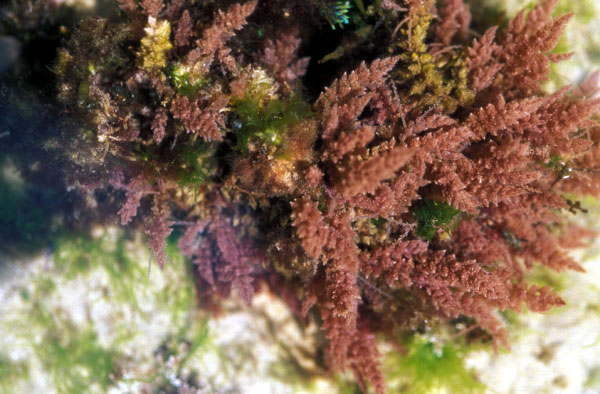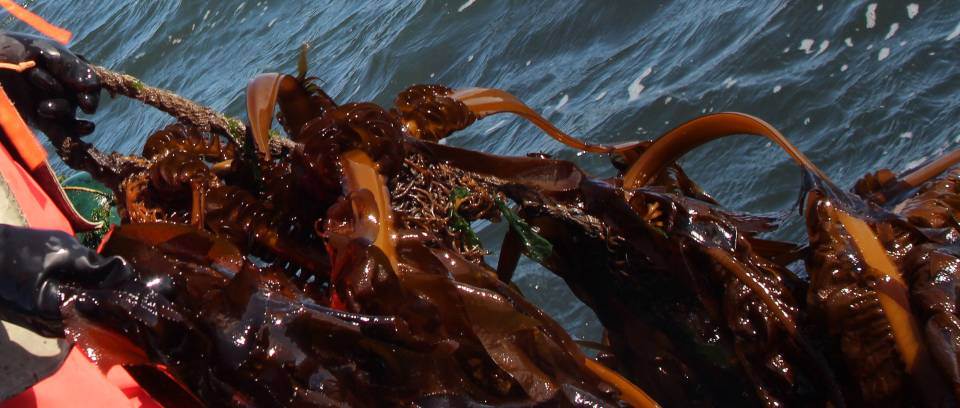Seaweed farming at sea is proving an increasingly competitive biomass production alternative for food and related uses. Farmed seaweed output has been growing exponentially, reaching 24 million tons by 2012. Remarkably, 99 % of this production occurred in merely eight Asian nations. Most of the remaining 150 countries and territories with coasts are yet to begin seaweed farming. With current technology and extensive available sea areas, requiring no land, freshwater or fertilizers, seaweed production can expand sustainably to the scale of agriculture, while providing a variety of valuable ecosystem services. Following a deductive or principle-based approach, that establishes seaweed primary productivity as a basis for food production, this chapter describes the fundamentals of seaweed farming, harvest and post-harvest techniques, ecological and economic considerations and a perspective on opportunities and challenges. The objective is to provide both an overall account of the state-of-the-art on seaweed farming as well as a contribution to the industry's sustainable development.
Digital library
-
-
A detailed understanding of physiological and reproductive processes in seaweeds has repeatedly proven to be an essential pre-requisite in the successful development of a sustainable industry. The prime example of this was the classical discovery of the “conchocelis”- phase of Pyropia (Porphyra) by Kathleen Mary Drew-Baker in 1949. Such elegant research proved to be pivotal to the development of a globally important “nori” industry which transitioned from the simple provision of the enhanced surface area of the substrata for spore settlement to the sophisticated, mechanized and computerized operations in modern hatcheries supplied by seedling banks of selected species and their cultivars. All of the pre-requisite knowledge was acquired through intensive applied research. However, not all solutions need to be high-tech; problems caused by epiphytes and contaminants have been achieved by exposing Pyropia nets periodically and was found to be effective. This protocol was achieved based on fundamental observations by farmers which were then complemented and refined by laboratory trials. Techniques must be adapted for site-specific differences, as abiotic factors such as water current and movement, surface seawater temperature, light regime and photoperiod, nutrients dispersion and water quality are interrelated, either positively or negatively, influencing seaweed productivity and the end-use of the biomass. Unfortunately, positive techniques that have been shown in vitro/silica can prove to be impractical once attempted at large-scale cultivation and/or the return on investment is not justified by the commercial value of the resultant seaweed biomass. This chapter presents a summary of how the judicious application of knowledge based on the ecophysiological processes of common seaweed species from tropical and cold-waters can assist the future development and scale-up of the global seaweed industry
-
Objective of Talk
Discuss the challenges with the selection of materials of construction, design of equipment, and assessment of equipment/material reliability for a continuous and commercially operating HTL (Hydrothermal Liquefaction) process in Saltwater environments
Agenda
1. Brief review of process operating conditions in HTL of Algal Biomass
2. Factors Affecting Materials Selection and Equipment Design
3. Considerations in Selection of Materials of Construction
4. Corrosion Mechanisms of Candidate Alloys
5. Factors Affecting Equipment Design
6. Conclusion and Recommendations
-
Caulerpa lentillifera (sea grapes) is widely consumed in SouthEast Asia as a low-energy food with high contents of vitamins and minerals. This study investigated dried sea grapes containing 16.6% insoluble fibre commercially produced in Vietnam as an intervention. We hypothesised that insoluble fibre is the primary metabolite that will reverse diet-induced metabolic syndrome. Male Wistar rats (n = 48) were randomly allocated to four groups in a 16 week protocol. Two groups were fed either corn starch (C) or high-carbohydrate, high-fat (H) diets for the full 16 weeks. The other two groups received C and H diets for eight weeks and then received C. lentillifera added to these diets for the final eight weeks (CCL and HCL, respectively). High-carbohydrate, high-fat diet-fed rats developed obesity, hypertension, dyslipidaemia, fatty liver disease and increased left ventricular collagen deposition. C. lentillifera supplementation in HCL rats decreased body weight, systolic blood pressure, plasma concentrations of total cholesterol and non-esterified fatty acids, inflammatory cells in heart and liver, and visceral adiposity. The Firmicutes to Bacteroidetes ratio decreased in the gut microbiota of HCL rats. Therefore, C. lentillifera attenuated cardiovascular and metabolic symptoms of metabolic syndrome in rats, possibly by preventing infiltration of inflammatory cells together with modulating gut microbiota.
-
To develop the most productive plants on earth - microalgae - to produce biofuels, nutritional oils, aquaculture and animal feeds while simultaneously reducing industrial emmissions of CO2.
-
Seven case studies are presented on commercial seaweed resources; five on wild crops, respectively Ascophyllum nodosum, Chondrus crispus, Gelidium, Laminaria longicruris and Macrocystis, are provided along with case studies of the farmed crops of Eucheuma and Laminaria japonica. Individually the cases range from descriptions of the wild crops and their management to the managed production of farmed crops including, in several examples, some information on economics and/or processing. These initial seven cases range from those emphaizing but one species from but one part of one country, to studies of a genus as it occurs commercially throughout the world.
-
The red alga Gracilaria lemaneiformis was cultivated with the scallop Chlamys farreri in an integrated multi-trophic aquaculture (IMTA) system for 42 h at Sanggou Bay, located in north China. Variation in inorganic carbon in the IMTA system was determined. The experiment included three treatments each with three replicates and three scallop monoculture systems as controls. Scallop density (399.1 ± 7.85 g per microcosm) remained the same in all treatments while seaweed density differed. The seaweed density was set at three levels (treatments 1, 2, 3) with thallus wet weights of 125.3 ± 4.72 g, 252.3 ± 7.50 g, and 378.7 ± 6.51 g per microcosm, respectively. This produced bivalve to seaweed wet weight ratios of 1:0.31, 1:0.63, and 1:0.96 for treatments 1, 2, and 3, respectively. In control groups, continuous dissolution of carbon dioxide (CO2) produced by scallops into the seawater not only caused an ongoing increase in partial pressure of CO2 (pCO2), 5.5 times higher than that of natural seawater, but also acidified seawater by 0.8 units after 42 h of culture. However, in all seaweed-scallop groups, the higher the algal density, the more CO2 was absorbed; pCO2 was lowest in treatment 3. The results suggest that a ratio of bivalve to seaweed less than 1:0.96 may produce an even stronger CO2 sink. Overall, the integrated culture of seaweed and scallop could provide an efficient and environmentally friendly means to reduce CO2 emissions from bivalve mariculture.
-
The objective of this study was to obtain the optimal medium for callus induction from thallus explants of Doty and to regenerate filamentous callus from induced callus. Before cultured cottonii seaweeds collected from the Natuna Islands (Riau Islands Province) were acclimatized in greenhouse and in semi-sterile culture in the laboratory. Sterilized explants were cultured on PES and Conwy media solidified with 0.8% Bacto Agar. In each of these media two combinations of plant growth regulators i.e. BA+IAA and BA+NAA were added. The concentrations of BA used were 0, 0.5, 1 mg/l, the concentrations of IAA were 0, 2.5, 5 mg/l, whereas the concentration of NAA were 0, 0.5, 1 mg/l. The result indicated that the optimal medium for callus induction was PES solidified medium supplemented with BA 1 mg/l. Types of callus formed were (a) white compact callus, (b) white filamentous callus, (c) greenish/brownish callus. Regeneration of callus into clumps of filament had been done by subculturing the callus into PES solidified medium supplemented with BA 1 mg/l + IAA 2.5 mg/l.
-
PowerPoint as PDF on our energy footprints, sustainability and aquaculture.
-
Until the late 1980s, there was little targeted harvest of bull kelp (Nereocystis luetkeana) in California, except as a small component of the localized edible seaweed industry. In central California, Nereocystis and Macrocystis often form mixed beds and it is likely bull kelp would have been incidentally taken during harvest of those beds, but not recorded separately on harvest records. Department records indicate about 19 tons of kelp, probably a mixture of Macrocystis and Nereocystis, were harvested from what is presently bed 302 off the Bodega Bay–Tomales Bay area between 1993 and 1999. All of this kelp was used by local abalone culturists. Other uses of bull kelp include pickling the stipe and marketing it as a specialty food product, and using the dried parts for arts and crafts. In southern Oregon, bull kelp was harvested from Orford Reef in the mid-1990s as an ingredient in liquid fertilizer. The Oregon Division of State Lands has since discontinued permitting that harvest





